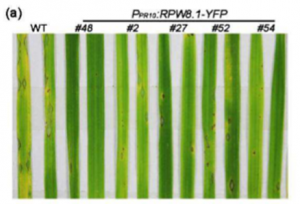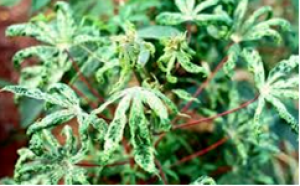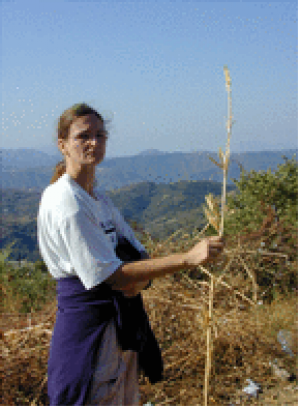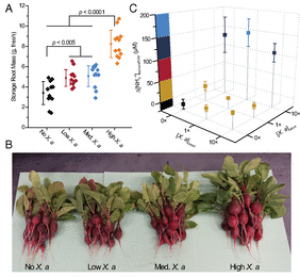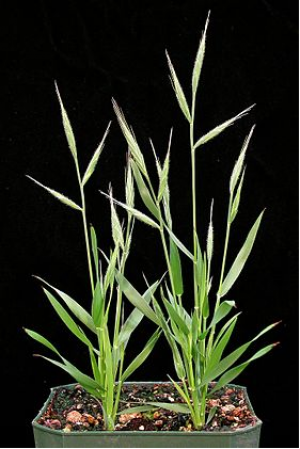The Arabidopsis gene RESISTANCE TO POWDERY MILDEW8.1 (RPW8.1) confers resistance to virulent fungal and oomycete pathogens that cause powdery mildew and downy mildew, respectively. However, the underlying mechanism remains unclear. Here, we show that ectopic expression of RPW8.1 boosts pattern-triggered immunity (PTI) resulting in enhanced resistance against different pathogens in both Arabidopsis and rice. In Arabidopsis, transcriptome analysis revealed that ectopic expression of RPW8.1-YFP constitutively up-regulates expression of many pathogen-associated molecular pattern-(PAMP-) inducible genes.
This study aimed to develop a methodology for eliminating cassava frogskin disease (CFSD) from in vitro shoot tip culture by associating thermotherapy and tetracycline. Cuttings from different accessions (BGM0232, BGM0315, BGM0464, BGM584, BGM0841, and BGM1342), infected with CFSD according to visual inspection of the disease symptoms, were used for cleaning.
Cornell University researchers have found out how E. coli bacteria defend themselves against antibiotics and other poisons. When undesirable molecules show up, the bacterial cell opens a tunnel through its cell wall and pumps out the intruders. According to Peng Chen, professor of chemistry and chemical biology, scientists have hypothesized on the assembly of these tunnels for a long time. Now the team has seen them.
The development of agricultural societies, one of the most transformative events in human and ecological history, was made possible by plant and animal domestication. Plant domestication began 12,000–10,000 y ago in a number of major world areas, including the New World tropics, Southwest Asia, and China, during a period of profound global environmental perturbations as the Pleistocene epoch ended and transitioned into the Holocene.
The nitrogen cycle and the fixation of atmospheric N2 into ammonium are crucial to global food production. The industrial Haber–Bosch process facilitates half the global nitrogen fixation in the form of ammonia but it is energy- and resource-intensive, using natural gas as the source of energy and hydrogen at elevated temperature and pressure. Our alternative approach synthesizes ammonium from N2 and H2O at ambient conditions powered by water splitting, which may be driven renewably.
A key feature in the evolution of all vernalization systems is a cold-regulated component. In pooid grasses, up-regulation of the flowering promoter VERNALIZATION1 (VRN1) by prolonged cold is a key feature of vernalization, although little is known about the genes that repress VRN1 prior to cold exposure or activate it afterward. Here, we report the identification of REPRESSOR OF VERNALIZATION1 (RVR1), a repressor of VRN1 that is involved in creating a vernalization requirement in Brachypodium distachyon. RVR1 is present in all sequenced flowering plant genomes but is not found outside the plant kingdom. This report describes a role for the RVR1 class of genes in plants and an upstream component of the VRN1 regulatory system.
As an E3 ubiquitin ligase, CONSTITUTIVELY PHOTOMORPHOGENIC 1 (COP1) directly ubiquitinates and triggers the degradation of various downstream targets and acts as a central repressor of light signaling. In this study, our data reveal that a Ser/Thr kinase, PINOID (PID), promotes photomorphogenic development. PID directly interacts with COP1 and phosphorylates it at the site of Ser20, thereby repressing the activity of COP1 in plants. Thus, our findings provide insight into the precise regulatory mechanism in maintaining appropriate COP1 activity in response to dynamically changing light conditions in plants.
Solanum tuberosum (potato) as a drought sensitive plant is also one of the most promising plants to meet the demands for food and starch of a growing population. Distinguishing genotypes into tolerant and susceptible is therefore of utmost interest. We subjected eighteen potato genotypes and two wild species, S. tarijense and S. chacoense, to osmotic stress applied in vitro by addition of 0.2 m sorbitol to a solid medium.
Sub-Saharan Africa (SSA) faces twin challenges of water stress and food insecurity – challenges that are already pressing and are projected to grow. Sub-Saharan Africa comprises 43 % arid and semi-arid area, which is projected to increase due to climate change. Small-scale, rainfed agriculture is the main livelihood source in arid and semi-arid areas of SSA. Because rainfed agriculture constitutes more than 95 % of agricultural land use, water scarcity is a major limitation to production.
Soybean oil quality and stability are mainly determined by the fatty acid composition of the seed. In the present study, we constructed a high-density genetic linkage map using 200 recombinant inbred lines derived from a cross between cultivated soybean varieties Luheidou2 and Nanhuizao, and SNP markers developed by specific-locus amplified fragment sequencing (SLAF-seq).


 Curently online :
Curently online :
 Total visitors :
Total visitors :
